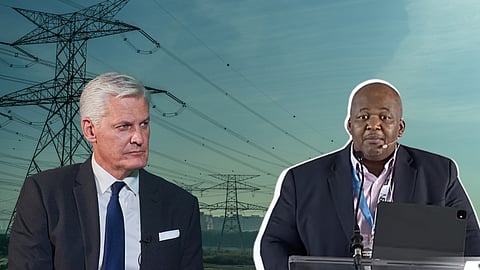Battle of the Eskom CEOs: De Ruyter’s momentum vs Marokane’s results
Key topics:
Eskom load-shedding fell from 329 days to just 4 under Marokane.
Profit jumped from R3.8bn to R25.9bn; EAF improved to 62.4%.
De Ruyter built momentum, but Marokane drove major operational gains.
Sign up for your early morning brew of the BizNews Insider to keep you up to speed with the content that matters. The newsletter will land in your inbox at 5:30am weekdays. Register here.
Support South Africa’s bastion of independent journalism, offering balanced insights on investments, business, and the political economy, by joining BizNews Premium. Register here.
If you prefer WhatsApp for updates, sign up to the BizNews channel here.
By Staff Writer
Eskom’s data showed that the power utility performed significantly better under its current chief executive, Dan Marokane, than under its former CEO, André de Ruyter.
De Ruyter’s tenure as chief executive has been a highly debated issue, with some praising him as exceptional and others questioning his leadership.
He told BizNews Investment Conference delegates that he took on a pretty tough job becoming Eskom CEO, and gave it his best effort.
“I really worked hard to try to make it a success. I think that I started to put some momentum back into the system,” De Ruyter said.
De Ruyter explained that running a large organisation can be easy once it has positive momentum, with legacy systems and procedures ensuring things run smoothly.
When De Ruyter assumed the top job at Eskom, he found that the momentum had gone entirely from the utility. He said he helped to fix this.
“I know I have this association with the Prince of Darkness, but I do think that I made that contribution to getting the momentum back,” he said.
He believes that the fruits of his labour were only seen after his departure, and that his tenure got the ball rolling regarding improvements at the generation facilities.
Read more:
His detractors often point out that South Africa experienced the worst load-shedding in its history during his tenure as chief executive.
Over the last two years, load-shedding has been nearly non-existent. This means many people blame him for the high blackout levels.
In an interview with ENCA’s Annika Larsen in early 2023, he admitted that his biggest failure as CEO was the poor performance of Eskom’s coal-fired power plants.
He told Larsen he failed in the readily measurable objectives, including load-shedding. “That is the elephant in the room,” he said.
“Promising to end load-shedding was one of my biggest early mistakes. I had completely misjudged the severity of the challenge.”
However, in recent interviews, he argued that Eskom’s improved performance was not purely due to better management at Eskom.
De Ruyter stated that it was the result of several factors, including the completion of several large generating units and the increased use of diesel fuel.
Another factor was private investment in new solar generation capacity, which takes pressure off Eskom’s grid and helps it to meet demand, which has declined.
Dan Marokane should get credit – Mteto Nyati
Dan Marokane officially started his role as Eskom Group Chief Executive Officer (CEO) on 1 March 2024 and was tasked with ending rolling blackouts.
Under his tenure, Eskom’s performance improved significantly, and the country experienced a substantial reduction in load-shedding.
Eskom’s Q2 Business Performance Report for the 2026 financial year revealed how much the power utility has improved.
Load-shedding was reduced from 329 days during its peak to only 4 days in the current financial year.
Eskom’s energy availability factor (EAF), a core measure of generation reliability, improved from an average of 58.7% in September 2022 to 62.4% in September 2025.
Eskom’s profit after tax increased significantly over the last three years, from R3.8 billion to R25.9 billion. It also has much healthier levels of liquidity.
Earnings before interest, taxes, depreciation, and amortisation (EBITDA) improved from R37.9 billion to R68.3 billion in three years.
Eskom added that it reduced its spending on open-cycle gas turbines (OCGTs) from R30 billion in 2023 to an expected R8.5 billion in the current financial year.
It highlighted improvements in key operational KPIs, including the installation of transmission lines and a reduction in energy losses.
Eskom board chairman Mteto Nyati said Marokane did not receive the credit he deserved in turning Eskom around.
He said comparing media reporting on Eskom during De Ruyter’s tenure as CEO to that of the utility under Marokane shows bias.
“If André de Ruyter had done half of what Dan Marokane has done in Eskom, he would be called Mr Fix-it,” he said.
“Instead, Dan’s efforts are overlooked, attributing Eskom’s turnaround to the private sector or a miracle.”
What the numbers say
With such diverse views on the performance of De Ruyter and Marokane, the best way to assess the situation is to look at the numbers.
Read more:
MyBroadband examined key performance indicators under De Ruyter’s last year as Eskom CEO, and Marokane’s latest year in the same position.
The data shows that Eskom is performing significantly better under Marokane than under De Ruyter in most metrics.
The table below shows Eskom’s performance comparison for the 2023 (De Ruyter) and 2025 (Dan Marokane) financial years.
This article was first published by MyBroadband and is republished with permission

